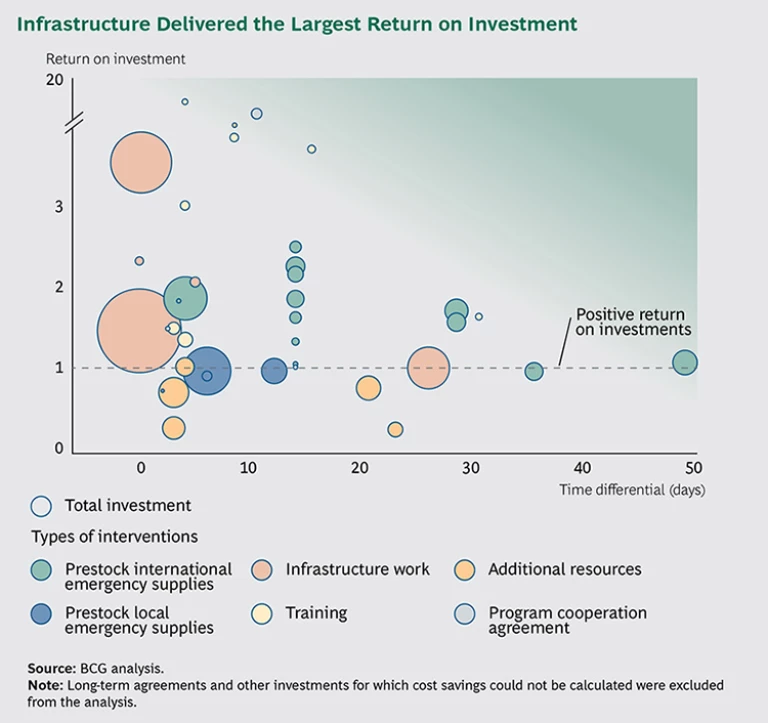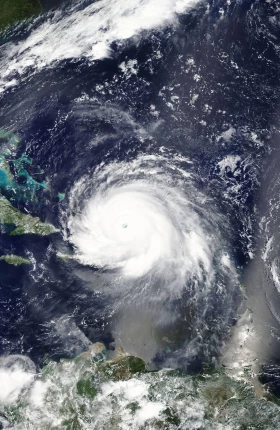Devastating events, such as Nepal’s recent massive earthquake and Typhoon Haiyan that hit the Philippines in 2013, remind us of the enormous human and financial costs of natural disasters. International aid agencies have long emphasized the need for emergency preparedness to improve the speed and effectiveness of disaster response when natural and man-made events occur—especially in risk-prone areas. But the payback of such investments has rarely been quantified.
To gain greater clarity about the benefits of emergency preparedness, Unicef and the World Food Programme (WFP) engaged The Boston Consulting Group to analyze investments made in the countries of Chad, Pakistan, and Madagascar. The goal was to quantify the time and cost savings of specific preparedness interventions and to determine which ones delivered the greatest return on investment (ROI). Several types of interventions were analyzed: prestocking emergency supplies, infrastructure improvements, training to enhance staff capabilities, and negotiating long-term agreements with suppliers. Of the 49 emergency-preparedness interventions that were studied, 64 percent are expected to save both time and money in an emergency, and 93 percent would shorten response times by more than one week, on average. Because of its direct link to the number of lives saved, speed is especially critical in an emergency.
Even more impressive is the ROI. The $5.6 million invested in these interventions is expected to deliver $12 million in savings during emergencies. Taken together, these results make a strong case for the early funding of emergency preparation, as summarized in the final report, “ Unicef/WFP Return on Investment for Emergency Preparedness Study. ” Let’s take a closer look at the three countries the study analyzed and some of the more effective interventions.
Chad: Political Conflict and Hazardous Climate
Chad is one of the poorest countries in the world, a problem aggravated by its proximity to the violent conflicts in the Central African Republic, Libya, Nigeria, and Sudan. The small country is exposed to recurrent droughts, floods, and crop failures, which result in poor access to water and health services, food shortages, spiking food prices, and malnutrition. Chad’s neighbors are unreliable sources of supplies. And being a landlocked country with limited local-transportation options, it faces severe logistical constraints that hinder the rapid movement of emergency products and services. On the basis of the country’s characteristics, the research study identified three main risk scenarios: conflict-related population displacement (including internally displaced persons, refugees, and returnees), droughts, and floods.
The interventions in Chad that were studied included prestocking emergency supplies, emergency training, and two relatively costly infrastructure projects: setting up an operations hub in Bol and rebuilding the Tissi airstrip. Though the airstrip required the biggest investment, it also delivered one of the greatest returns on investment.
The Tissi area sees periodic inflows of refugees and returnees owing to its strategic location close to the borders of the Central African Republic and Sudan. Delivering humanitarian aid to the area during the rainy season was difficult, as the roads in Tissi become inaccessible for about five months. Air transport was the only way—and only helicopters at that. Fixed-wing aircraft were unable to land and take off. Now that the airstrip has been rebuilt, fixed-wing aircraft can be used throughout the year. The airstrip was rehabilitated at a cost of $680,000—the second-largest investment in the study—but it should deliver savings of $5.2 million over a period of ten years. These significant savings lead to an exceptionally high ROI of 7.7 and will allow for a very fast payback.
Pakistan: Large Population, Large-Scale Needs
Sharing a long and porous 1,640-mile border with Afghanistan, Pakistan is located in a politically unstable and strategically sensitive region. Since 2008, the military’s operations to secure the country’s northwest region have led to major population displacements and refugee camps—along with serious issues related to social welfare, security, and humanitarian access. Emergency response and recovery operations have also been hampered by security restrictions in the volatile area.
Natural disasters add to Pakistan’s challenges. The country is frequently flooded by monsoon rains. The 2010 floods affected 20 million people and left 10 million in need of assistance. Pakistan’s location at the center of tectonic plates makes it vulnerable to earthquakes as well, and some areas experience severe drought-like conditions. Combined, these problems have contributed to a sharp increase in hunger and malnutrition. On the basis of Pakistan’s characteristics, the research study identified four main risk scenarios: security operations, floods, earthquakes, and drought-like conditions.
Because of the country’s many risks and large population (more than 180 million people), Unicef and WFP both maintain large-scale operations in Pakistan. But on the plus side, the country has a developed national-transport infrastructure, a well-established supply chain, strong local markets, and a government that has increased its capacity for emergency response over the past few decades.
The study analyzed a range of investments that have been made in Pakistan. One of the most successful was an elevated warehouse in Peshawar designed to protect stored supplies and food from the elements. Peshawar is an important logistical hub not only for local operations but also for neighboring Afghanistan. To minimize losses from rain and floodwater, three-foot-high concrete platforms were built to raise the warehouse, and 45 mobile-storage units were installed to improve efficiency and expand covered-storage capacity by an additional 10,000 to 15,000 metric tons.
The improved and protected storage area will increase Peshawar’s ability to support the region during emergencies. Also worth noting are the large savings that the investment generated. Although the project required an up-front investment of $1.5 million—the largest in the study—it will save $100,000 every year by reducing food losses and the costs associated with tarps and plastic sheeting, on top of $2 million in savings in the event of a major flood.
Madagascar: Small, Low-Income, and at Risk
Madagascar’s gross national income (GNI) is among the lowest in the world. In 2010, almost 90 percent of the population lived on less than $1.25 a day. That is less than the GNI of Chad; however, the life expectancy and education level of Madagascar’s population are significantly higher. The country is only starting to recover from the political crisis that followed the coup in 2009, which led to the suspension of most international aid. Although aid organizations have gradually recommitted themselves since 2012, the volume of aid is still only half its precrisis level.
Like Chad and Pakistan, Madagascar is highly prone to natural disasters, and climate change now threatens to exacerbate those risks. In the past 40 years, more than 50 natural disasters have battered the island. The research study focused on two main risk scenarios: drought and cyclones (including the associated floods). Although the south suffers from regular droughts, much of the rest of the country is vulnerable to cyclones—often accompanied by floods. The island’s east coast used to be the main gateway for cyclones, but in the past two decades, the storms have started hitting the western coast with growing frequency and intensity. As the island’s ecosystem grows more fragile, Madagascar’s people must deal with ongoing food shortages and crushing poverty, making the country’s population extremely vulnerable to disaster.
The investment in Madagascar with the greatest ROI was a three-day training course on emergency response and management using information and communications technology (ICT). Besides analyzing gaps in current ICT capabilities, the course covered a wide range of topics, including operations management, business continuity planning, international law, and how to manage information and coordinate resources more effectively in the event of an emergency. The training was provided to 21 ICT personnel drawn from the country’s government, the United Nations (UN), nongovernmental organizations, and the private sector. The $19,700 investment is expected to deliver $59,300 in savings and cut emergency response time by four days.
The study also analyzed the ROI of emergency equipment prepositioning. Given how hard it is to predict where the next cyclone will land, the centralized location of Antananarivo, the country’s capital, makes it a strategic supply and communications hub. A range of ICT equipment was purchased and stored there. Two motorized boats were also bought and kept in Antananarivo. These will be made available to the UN community and government agencies to assess the extent of emergencies and to perform search and rescue operations in isolated locations. The ROI is up to twice the amount invested. Even more—as seen for ICT equipment in all pilot countries—the time savings of more than 30 days will make a difference in the next cyclone season.
Lessons from the Front Lines
Chad, Pakistan, and Madagascar were specifically chosen as pilot countries because of their diverse risk profiles and development stages and the varied sizes of local Unicef and WFP operations. Although some similarities in financial ROI and time savings were seen across all three countries, all results were influenced by factors such as transportation infrastructure, local-market capacity, distribution systems, and human capital. Although investments with high returns in one country won’t necessarily deliver the same returns in another country, the study suggested some patterns:
- Large infrastructure investments yield the highest absolute savings. (See the exhibit.)
- Training yields the highest ROI owing to its relatively small initial investment. But to fully capture the value, the trained staff must be retained to share knowledge and ensure quality.
- The more dependent a country is on external goods and services, the higher the return on any investment that ensures their availability in an emergency.
- In countries with higher coping capacities, the ROI for more basic emergency preparation fades, and the value shifts to training and improving organizational capacity.
We also noted that the investments all had additional qualitative benefits, such as boosting the reliability of emergency interventions and improving local expertise, which spilled over to the broader humanitarian community and aided in the countries’ overall development, further increasing the payback of the investments. Taken together, the findings clearly show that early funding of emergency preparedness leads to significant time and cost savings.









